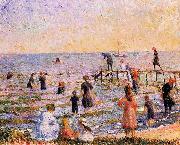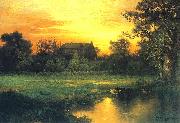
Oil On
Canvas, Real Flavor of Old Masters
|
James Augustus Suydam
|
|||
|
|
|||
| (1819-1865) architect, lawyer, and artist; as an artist was considered one of the premier Luminism painters. He is widely known as an American landscape painter and one of the leading members of the Hudson River School. James Augustus Suydam was descended from an old New York Dutch merchant family. He graduated from New York University (then the University of the City of New York), and began his career as a businessman but turned a significant portion of his energies to painting, studying under famed artist and portrait painter Minor C. Kellogg. At the age of thirty he was elected to the Century Association. One of the "regulars" who gathered to paint at North Conway, New Hampshire, he exhibited Conway Meadows at the New York Athenaeum and Boston Athenaeum. He opened his studio at the noted 10th Street Studio Building, New York City, in 1858. The following year he was elected an honorary professional member in the prestigious National Academy of Design, which granted him full membership in 1861. He died suddenly in North Conway at the age of 46. James Suydam was described by his friend, the accomplished artist Sanford Robinson Gifford as a "thoroughly educated and accomplished man. " In addition to his work as an artist, which he began only after working in law and architecture, he was widely read and well-versed in history, philosophy, and the sciences. His work as a landscape painter reflects this breadth of knowledge and reveals Suydam as a deeply spiritual individual. Using his familiarity with science, Suydam reduced nature to calm, clean, planar forms, and then distorted proportional relations so that God's creations loomed superior over the work of man. The National Academy has most of his works such as Paradise Rocks (1865), and the Taft family's Taft Museum also holds works. The Taft also has a podcast website for this artist. A painting of Gifford's from 1859 which Suydam, according to a report, "donated to the [National] academy in 1865," became the subject of a deaccession controversy at the Academy in late 2008. | |||
|
|
|||
|
|
Long Island new24/James Augustus Suydam-978385.jpg Painting ID:: 72671 Visit European Gallery |
"Long Island," oil on canvas, by the American Luminist painter James Augustus Suydam. Private collection. 1862(1862) cjr | |
Height Width |
INS/CM |
||
|
X |
|
||
|
|
|||
|
Thomas Moran
|
|||
|
|
|||
| b1837 UK d1926 Thomas Moran Locations Thomas Moran (February 12, 1837 - August 25, 1926) from Bolton, England was an artist of the Hudson River School who often painted the Rocky Mountains. Thomas Moran's vision of the Western landscape was critical to the creation of Yellowstone National Park. Thomas Moran along with Albert Bierstadt, Thomas Hill, and William Keith are sometimes referred to as belonging to the Rocky Mountain School of landscape painters because of all of the Western landscapes made by this group. | |||
|
|
|||
|
|
Long Island new24/Thomas Moran-477534.jpg Painting ID:: 79150 Visit European Gallery |
Oil on canvas laid on board, 18-1/8 x 26 in Date 1897(1897) cyf | |
Height Width |
INS/CM |
||
|
X |
|
||
|
|
|||
|
William Glackens
|
|||
|
|
|||
| 1870-1938 William Glackens Galleries William James Glackens (March 13, 1870?CMay 22, 1938) was a U.S. realist painter. Glackens studied at the Pennsylvania Academy of the Fine Arts and later moved to New York City, where he co-founded what came to be called the Ashcan School art movement. This group of artists, dubbed by the press "the Eight Independent Painters" or The Eight, chose to exhibit their works without pre-approval by the juries of the existing art establishment. He became known for his dark-hued paintings of street scenes and daily life in the city's neighborhoods. His later work was brighter in tone, and showed the influence of Renoir. During much of his career as a painter, Glackens also worked as an illustrator for newspapers and magazines in Philadelphia and New York City. | |||
|
|
|||
|
|
Long Island new24/William Glackens-957359.jpg Painting ID:: 79223 Visit European Gallery |
Oil on canvas, 26-1/16 x 32 in; Location: Brooklyn Museum Date 1911(1911) cyf | |
Height Width |
INS/CM |
||
|
X |
|
||
|
|
|||
|
Thomas Moran
|
|||
|
|
|||
| b1837 UK d1926 Thomas Moran Locations Thomas Moran (February 12, 1837 - August 25, 1926) from Bolton, England was an artist of the Hudson River School who often painted the Rocky Mountains. Thomas Moran's vision of the Western landscape was critical to the creation of Yellowstone National Park. Thomas Moran along with Albert Bierstadt, Thomas Hill, and William Keith are sometimes referred to as belonging to the Rocky Mountain School of landscape painters because of all of the Western landscapes made by this group. | |||
|
|
|||
|
|
Long Island new24/Thomas Moran-439876.jpg Painting ID:: 79857 Visit European Gallery |
Oil on canvas laid on board, 18-1/8 x 26 in Date 1897(1897) cyf | |
Height Width |
INS/CM |
||
|
X |
|
||
|
|
|||










